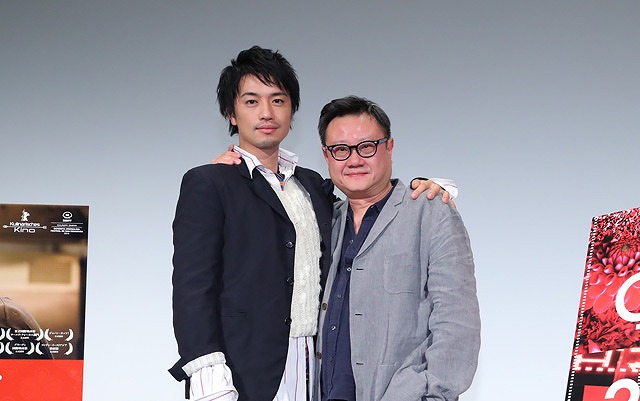
Connecting Cultures Through Hearts and Stomachs
Acclaimed Singaporean director Eric Khoo and popular actor Takumi Saitoh (Blank 13, Last Winter We Parted) were on hand to answer questions from the press following the packed Japan premiere of Ramen Teh, playing in the 31st TIFF World Focus section on November 1.
“I got the feeling the audience was very hungry following the screening,” remarked Khoo.
In the film, ramen chef Masato (Saitoh) decides to explore his Singaporean mother’s roots after his father suddenly passes away. Upon arriving in Singapore, a Japanese food blogger (90s pop star Seiko Matsuda) takes him on a tour of the city’s gastronomic delicacies, including the pork bone broth called “bak kut teh.” She also helps him track down his mother’s family, who disowned their daughter when she married a Japanese man. Masato eventually sets his culinary sights on making a hybrid dish that fuses his chewy Japanese noodles with the savory Singaporean soup in the hopes of bridging the two cultures and families.
Both Khoo and Saitoh remarked that they could hear audience members talk about what they wanted to eat for dinner following the screening of the film, a reaction that echoed what they heard at film festivals such as the Berlinale and New York’s Japan Cuts, where the film had already played. Khoo revealed that an interviewer at the Berlinale was crying after the film because she missed the food of her grandmother. “As we’ve seen at many festivals,” Khoo said, “people really engage with the film because food and the memories they evoke are very universal.”
Both the story and filming of Ramen Teh begin in Japan, where Saitoh had to prepare for his role as a ramen chef by making his own noodle broths from simmered clams. “I kept screwing up and having to make it over, again and again,” said Saitoh.
Once shooting in Singapore began, however, Saitoh and Masato were one, learning how to make Singaporean food on the fly. Saitoh said the filmmaking and cooking processes are very similar: “You gather the ingredients, season them, enjoy the final product, and then put everything away.”
The film gloriously captures the vibrancy of Singapore’s diverse food centers, where hawkers serve specialties that mix Chinese and Southeast Asian food traditions such as chili crab, laksa noodles, fish head curry, Hainanese chicken rice, and, yes, the eponymous bak kut teh, which is presented in mouth-watering detail.
The pairing of ramen with bak kut teh at the center of the film’s themes is a clever choice that Singaporeans would be familiar with, considering the country has over 180 ramen restaurants, and about 400,000 Singaporeans come to Japan each year for food tourism. Khoo revealed that ramen is his favorite noodle, and the pairing of the two foods is because “these are earthy foods from the country, or street food. I feel that street food is soul food, it’s from the heart, and that’s the film.”
Though Khoo and Saitoh wouldn’t reveal their favorite ramen restaurants, they did test how the culinary fusion dish would work through enlisting the help of noodle-making friends. Saitoh was particularly surprised at the popularity of Japanese food in Singapore, upon seeing the abundance of ramen and revolving sushi shops in the city. “The tastes of the two countries seem to be very similar,” said Saitoh, “so a dish like ramen teh was necessary to unite the themes and cultures.”
Ramen Teh is a Japan-Singapore-France co-production, and Khoo and Saitoh talked about the need for increased international collaboration in the Asia region. “We are a very small country in Singapore, so it’s important for our films to travel and be seen by overseas markets to be viable,” said Khoo. “As a Singaporean filmmaker, I feel it is very important to have this collective effort in Asia with Asian filmmakers.
Khoo recently produced the HBO horror miniseries Folklore, featuring an episode directed by Saitoh , who also spoke about Japan’s need to increase collaboration. While Saitoh acknowledged that financing films for release in the international market is difficult, working on Ramen Teh and Folklore made him realize the strength of a project “from Asia.” “I think we are entering an era,” said Saitoh , “where we need to use the various assets – financial, technical, creative – that are available across Asia to create entertainment not just for the 130 million people in Japan, but for the 7 billion around the world.”